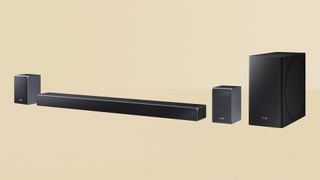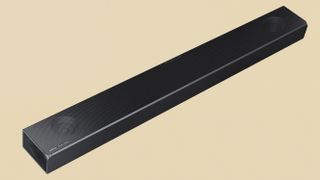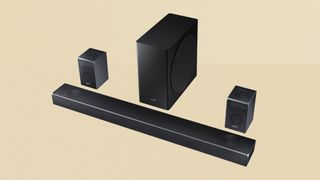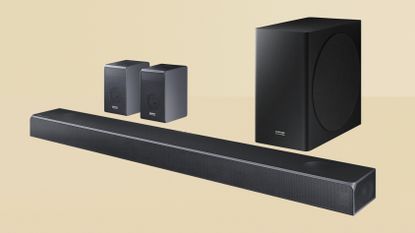Welcome to T3's Samsung HW-Q90R review. This is Samsung’s current flagship soundbar, a position it earns by combining a massive 512W of total output power with a 7.1.4-channel speaker system capable of delivering Dolby Atmos and DTS:X movie soundtracks with genuinely spectacular potency and precision.
And Samsung promises that's a real 7.1.4 system – it's not claiming it via virtualisation of rear speakers, in the way that the Sony HT-G700 does. There are a whopping 17 speaker drivers in play in the whole setup here, divided between four boxes: the main soundbar, which handles centre and forward-side channels, plus has upfiring drivers for Atmos height channels; the subwoofer; and two wireless rear speakers, which provide rear side channels, but also have an upfiring driver each, for rear Atmos height channels.
The result, as we'll see, is easily the most immersive experience for Dolby Atmos/DTS:X surround sound you can get for its price, and is well deserving of its high place in our list of the best soundbars.
One quick note before we start: if the name sound familiar, that's because it's almost identical to one of Samsung's TVs. The Q90R was the name of Samsung's flagship 4K TV in 2019, and 2020's equivalent model is the Samsung Q90T. The only way to tell them apart when searching online is to be sure to add the "HW-" when hunting for the soundbar.
We get why Samsung did this – give them the same name to indicate that they kind of go together, and match in terms of quality and technology – but it's so unnecessarily confusing.
- Meet the best TVs on the planet
- Or just the best OLED TVs
- See the best TVs under £1000
- And the best TVs under £500

Samsung HW-Q90R Dolby Atmos soundbar review: Price, release date and features
The Samsung HW-Q90R was originally released in May 2019, and remains Samsung's fanciest soundbar offering still – but it's had some price cuts since its release. You can now find it for £999/$1,699.
This price still makes it far from a budget soundbar – indeed, it's way up at the premium end, especially in the US – but it justifies that price, with a range of key features that you just don’t normally find in the soundbar world. And, actually, it provides them while undercutting a lot of newer competition that's come in also at the high end, such as the LG SN11RG.
For starters, there are no less than four separate speakers included in the box, rather than the usual one or two. This is because the Q90R ships with actual rear speakers, rather than creating rear channel sound effects ‘virtually’ using processing, like most soundbars too.
These rear speakers are wireless, and remarkably carry two speakers each, not just one. So as well as the normal forward-facing driver, you get up-firing speakers built into their top edges. These are angled forward slightly, so they can bounce sound off your ceiling in a way that ‘meets up’ with similar up-firing drivers built into the top of the meaty main soundbar.
These up-firers create the ‘.4’ part of the 7.1.4 sound channel configuration, creating a proper hemisphere of sound into which Dolby Atmos and DTS:X soundtracks can place their audio ‘objects’. It’s great to find a soundbar system going to such lengths to ensure that the object-based sound formats’ rear and overhead effects are treated with so much respect.
As well as the rear and main soundbar speakers, the HW-Q90R ships with a meaty-looking subwoofer with an 8-inch driver. There are a further 12 drivers in the main soundbar, including two angled drivers built into the soundbar’s ends that are designed to fill in the all-important Dolby Atmos/DTS:X side channels.
Connections on the HW-Q90R include two HDMI inputs and a single HDMI output, all capable of passing through 4K and HDR video to your TV, including the premium Dolby Vision and HDR10+ formats. This is great because it means the soundbar is actually adding an HDMI port to your TV, but is also handy if your TV doesn't support Dolby Atmos (and therefore can't pass it through to a soundbar) – you can plug your boxes directly into the soundbar, it will correctly use the Atmos or DTS:X soundtrack before it even reached the TV.
You can also stream music into the soundbar via Wi-Fi or Bluetooth, in a wide range of audio formats. These include high-resolution formats such as FLAC, WAV, AAC and ALAC.
There’s Alexa voice control support, and eARC for receiving lossless Dolby Atmos sound over HDMI from eARC-capable TVs.
A unique Game Mode Pro technology, meanwhile, can automatically optimise audio playback for a more dynamic sound experience that positions you more specifically at the heart of the gaming world.
There’s actually an Adaptive Sound feature, too, that automatically tries to optimise sound to match whatever type of content you’re watching. The results of this aren’t as consistently helpful as the Game Mode, though, and the base audio set up on this flagship soundbar is so good that I never really felt I needed Adaptive Sound’s help. There’s no harm experimenting with the feature, though – especially in the unlikely event that you find dialogue sounding a bit lost with a particular source.
Finally, the front-firing tweeters the HW-Q90R uses enjoy a wide-dispersion design, so you don’t have to sit in very specific position to get a convincing sense of immersion.

Samsung HW-Q90R Dolby Atmos soundbar review: Sound quality
The Samsung HW-Q90R’s sound is on a whole other level to that of almost any other soundbar I’ve tested.
For starters, it can handle huge amounts of power and volume without suffering any common unwanted side effects such as chassis rattles, bass thuds, treble harshness or sudden power ‘drop outs’. And since it can deliver so much power with no accidental nasties in tow, it can actually sound more spectacularly cinematic than some bigger, less tidy-looking separates systems.
In fact, while the speakers in the HW-Q90R system are fairly substantial by soundbar standards, it’s nonetheless hard to believe that the colossal volumes and huge scale of sound you’re hearing can be coming from a speaker system that looks so tidy relative to a typical separate surround set up.
The HW-Q90R is not just about loudness, though. It also moulds that volume into a remarkably well-defined and immersive soundstage that makes full use of the width and height of your room. In fact, thanks to a combination of its volume and speaker configuration, it creates one of the most convincing Dolby Atmos/DTS:X ‘hemisphere’ of sound that I’ve heard from a soundbar (the more expensive LG SN11RG also excels here).
The rears with their up-firing drivers are particularly key to this, filling in the top of the object-based soundstage’s ‘dome’ in a way not even the cleverest virtual height effect systems can.
In fact, there’s no sense of any ‘holes’ in the HW-Q90R’s bubble of sound, which makes movie soundtracks so much more convincing and involving.
Adding to the immersion is way the speakers have enough power and dynamic range to scale up with total conviction from quiet talky scenes to epic space battles or dinosaur attacks without ever sounding strained or boxed in.
The big subwoofer underpins the scale of big action moments with exceptional amounts and depths of bass, yet this always sounds accurately attached to the bottom of the exceptional mid-range dynamics delivered by the main soundbar. There’s no sense, in other words, of a gap between the lowest register of the main soundbar and the bass levels of the subwoofer.
There’s nothing brash or unrefined about the massiveness of the HW-Q90R’s sound, either. The clarity retained within the volume renders perfectly well all the subtle layering and detail positioning that go into a well-crafted movie mix. And voices always sound clear and full of context, no matter how much other sound they’re having to compete with.
Provided your room layout doesn’t limit the impact of any of the HW-Q90R’s speaker design (more on this in the next section), it’s truly hard to fault its movie performance. Perhaps inevitably, though, its clear focus on movie and TV soundtracks means the HW-Q90R lacks a touch of refinement and flexibility with music. There’s a slightly aggressive, cold feel to at least some musical genres compared with the smooth, inviting warmth you get with soundbars that come from more hi-fi-oriented brands.
That’s not to say the HW-Q90R actually sounds bad with most (especially rock and pop) music, though. It’s just not quite as comfortable with music as it is movies.

Samsung HW-Q90R Dolby Atmos soundbar review: Design & Usability
The Samsung HW-Q90R isn’t the prettiest of soundbars. The subwoofer is a big black tower of a things, for starters – though you can tuck it out of sight behind the end of a sofa without heavily impacting its performance.
The main soundbar is chunkier in all directions than most of today’s soundbars. Its 83mm height, in particular, could see it jutting into the pictures and/or over the infra-red receivers of some TVs. Though it’s designed, of course, to fit perfectly under Samsung’s current high-end TVs – for other manufacturers, you may just want to check.
The rears are fairly substantial too, though not so much that they can’t still sit on a bookcase or shelf on your back wall.
All of the separate speakers connect wirelessly, by the way, so apart from power cords there’s no cabling to have to hide.
Tucked away a little awkwardly on the right-hand side of the main soundbar’s front edge is an LED window. This provides handy updates on the input you’ve got selected, what sound format the soundbar is receiving and so on. This window also makes it easier to set up the relative balances of the system’s various sound channels.
Setting up the HW-Q90R on your Wi-Fi network is a bit of a faff, but nothing you can’t handle if you stay calm and patient. More frustrating is the way the rear speakers or subwoofer sometimes lose their wireless connection, requiring you to have to switch all the speakers into wireless reset mode to get them talking to each other again. It's not all the time, and you can see that we clearly don't find it a dealbreaker, but it happens.
It’s also worth noting that to get the absolute best from the HW-Q90R, your room layout will need to play ball with its speaker configuration. In other words, ideally you’ll have a flat, beam-free ceiling, and side walls that are more or less equidistant from the two side-firing speakers in the soundbar’s end panels.

Samsung HW-Q90R Dolby Atmos soundbar review: Verdict
If you’re a serious film fan who wants truly cinematic sound in your living room without having to accommodate a substantial separates system, the Samsung HW-Q90R is in a class of its own for under £1000.
There’s nothing else out there in the same price bracket that can match its combination of power, clarity and, best of all, full Dolby Atmos/DTS:X immersion.
All of which makes that initially steep-looking price tag suddenly look a whole lot more reasonable.
Samsung HW-Q90R Dolby Atmos soundbar review: Also consider
If you’re after a soundbar that prioritises music over movies, you might be better looking at the Sonos Arc, which is also equipped with an array of drivers for Dolby Atmos sound, but also functions better as part of a multi-room music setup. However, it doesn't come with rear speakers or a subwoofer, though you can add both (the cost will stack up quickly, mind). The Sonos Arc also only has a single HDMI port, which can cause problems in some instances – see our full Sonos Arc review for all the details. It's a truly brilliant-sounding soundbar, however, for movies as well as music.
The most direct competitor to the Samsung Q90R is the LG SN11RG, mentioned earlier, which matches it for being a full surround system, and is similarly powerful and dynamic. That's a huge beast of a bar, and adds lots more onto the price without hugely surpassing the HW-Q90R, though. Read our LG SN11RG review to see what you think, but even though we really love the LG, we think most people will choose the lower price of the Q90R given that there's no real downside.
If you want as close to this experience as possible, but for much cheaper, you'll need to take a look at our Vizio 5.1.2 Dolby Atmos Soundbar review. This system saves you hundreds over the Samsung, but still provides a four-box system, with rear speakers and subwoofer, as well as the soundbar. The lower price means that the rear speakers don't have upfiring drivers, so the 'dome' of sound isn't as totally enveloping, and the rear speakers are also wired to the subwoofer (though the subwoofer connects wirelessly to the main bar). It's a really impressive system for the price, and we totally recommend it for those whose budget doesn't stretch to the HW-Q90R.
If you want the lowest-priced possible bar that can even be mentioned in the same breath as the HW-Q90R, look to our Sony HT-G700 review. This is less than half the price of the Q90R, and doesn't have rear speakers at all, or dedicated upfiring drivers for Atmos height. However, its virtualisation of height and width is better than anything else in its price range, and the subwoofer gives it lots of meat for movies still.




